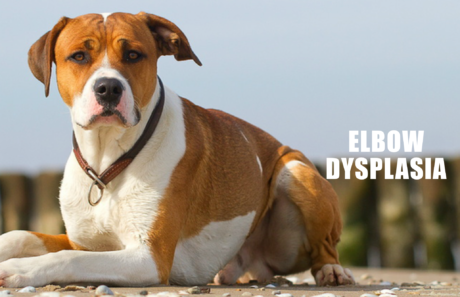
If Your Dog’s Gait is Changing, Check for Elbow Dysplasia
Don’t miss the video at the bottom where Dr. Karen Becker discusses four types of canine elbow joint problems that fall into the general category of “elbow dysplasia.”
“Elbow dysplasia” is a catchall term used to describe one or more inherited developmental abnormalities in a dog’s elbow joint.
Generally speaking, elbow dysplasia means the development of arthritis in the elbow joint.
Four Types of Elbow Joint Problems
There are four developmental problems that can occur in a dog’s elbow joint:
- Ununited anconeal process (UAP) – describes a condition in which the bony protuberance within the elbow becomes detached from the ulna and causes joint irritation and degeneration.
- Fragmented coronoid process (FCP) – describes a small piece of ulna bone that breaks off inside the elbow joint. This little piece of loose bone irritates the lining of the joint and wears away the cartilage of the humerus.
- Osteochrondrosis dissecans (OCD) – is a condition in which a piece of cartilage comes loose or pulls away completely from the surface of the joint, resulting in inflammation and pain. After the inflammation or “itis” is gone, the condition is called osteochrondrosis dessicans.
- Elbow incongruency – is a term used to describe imperfect conformation of the joint, which causes the cartilage to wear down quickly.
Three bones make up the joint of a dog’s elbow: the radius, the ulna, and the humerus. These three bones are supposed to grow together and fit perfectly to form the elbow joint.
Who Develops Elbow Problems?
Certain breeds are predisposed to elbow dysplasia, including Golden and Labrador retrievers, English setters, English Springer spaniels, Rottweilers, German shepherds, the Burnese mountain dog, Chows, the Shar-Pei, and Newfies.
If you rescued your dog, you obviously don’t have a choice when it comes to his DNA. However, if you plan to purchase a dog at high risk of elbow dysplasia from a breeder, I strongly suggest you insure your prospective pup’s parents have been cleared for elbow dysplasia by OFA, which is the Orthopedic Foundation of America.
Elbow dysplasia typically occurs in puppies between 4 and 10 months, but some dogs don’t show any signs of the problem until they develop degenerative joint disease as adults. The problem usually affects both elbows, but sometimes it’s unilateral, meaning it only occurs in one elbow.
Symptoms of an Elbow Deformity
Dogs with elbow dysplasia are often lame or they have an abnormal gait (they ‘paddle’ or ‘flip’ their front feet when they walk). Sometimes elbow dysplasia causes dogs to hold their elbows out or tightly into their bodies, and often a dog’s feet will rotate outwards. Sometimes dogs with this condition will choose to spend much of their time sitting or lying down, and when they play it’s usually not for long periods of time.
Dogs with elbow dysplasia tend to tire easily, and their owners may assume they’re just lazy or quiet when really their elbows hurt. You might also notice your dog is stiff when he attempts to stand, and exercise frequently makes the situation worse, not better.
If your dog has dysplasia in both elbows, his lameness may shift from one leg to the other. When both legs hurt equally, dogs with this condition don’t limp. They alter the way they stand and walk in order to shift their weight back and forth. If one elbow hurts more than the other, you’ll notice an obvious limp.
Diagnosing an Elbow Problem
Diagnosis of elbow dysplasia is usually made by observing clinical signs, palpation of the joints, and taking X-rays of the elbow joint. A dog with elbow problems will often resist any attempt by the veterinarian to manipulate the elbow.
Joint capsule swelling can sometimes be felt, especially after exercise. The joint capsule can also appear thickened. There can be changes to the musculature in the shoulders, so muscle atrophy is not uncommon.
X-rays will permit the vet to visualize abnormalities in the appearance of the joint, as well as increased bone density at the ulnar notch. They will also sometimes (but not always) show lesions caused by OCD, as well as ununited anconeal process, a missing coronoid process, and arthritis.
A CAT scan can also be used to arrive at a definitive diagnosis, as well as to perform a minimally invasive diagnostic arthroscopy, which involves passing a tiny camera inside the joint.
Treatment of Elbow Dysplasia
The goal of treatment of elbow dysplasia is to relieve pain and maintain function in the affected limbs. We want to help these patients live active, normal lives. The type of treatment given depends on several factors, including the amount of pain the dog is living with, and the extent of arthritic changes to the joint.
If the dog’s quality of life is compromised, the treatment of choice in many cases is arthroscopic surgery. An ununited anconeal process is typically removed through a small incision made in the elbow. Studies suggest that if a UAP is detected early enough, an ulnar osteotomy, which is the cutting of the ulna bone, can be used to reduce stress and potentially allow the UAP to unite normally in a growing puppy.
It’s very important for dogs with elbow dysplasia to stay at a very healthy, normal weight, and to get moderate exercise. Sometimes veterinarians say, “Don’t exercise the dog at all,” but that advice often results in significant muscle atrophy.
Dogs with elbow dysplasia usually respond well to rehabilitation therapies such as underwater treadmill/swim therapy, massage, joint mobilization and therapeutic exercises.
Anti-inflammatory medications are often prescribed for elbow dysplasia patients, but I’ve had really good success using natural anti-inflammatory agents like esterified fatty acid complex.
If arthritis is present, injectable polysulfated glycosaminoglycans, which is a big fancy term for injectable substances such as Adequan, can be of great benefit.
I also use proteolytic enzymes to help reduce inflammation, as well as CPAs, which are chondroprotective agents such as eggshell membrane. Cetyl myristoleate, or CMO, can be used to reduce cartilage deterioration.
I’ve had many dog patients diagnosed with elbow dysplasia that were managed very successfully without surgery, because their owners proactively addressed inflammation and joint degeneration as soon as the diagnosis was made.
In fact, one such dog is Bubba. Bubba’s dad was told his big guy needed surgery for elbow dysplasia. He came to me for a second opinion, and fortunately, we’ve been able to keep Bubba 100 percent symptom-free using a combination of some of the alternative therapies mentioned above.
Author: Dr. Karen Becker
Link: https://www.caninearthritisandjoint.com/elbow-dysplasia.html



